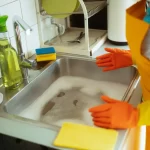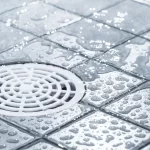We all know that a dishwasher leak is a very annoying problem. And if we ignore it, it can cause more serious damage and might lead to expensive repairs. That’s why it is important to learn more about dishwasher leaking. Particularly in finding the source of the leak, whether it’s coming from the door, the bottom, or the hose connections, as well as resolving the problem and keeping it from happening again.
In this blog, we’ll walk you through the most common causes of a dishwasher leak, how to troubleshoot them, and when it’s time to call a professional. You’ll learn more about how to stop and resolve that leaky dishwasher from its tracks, from the clogged drains to faulty valves and damaged dishwasher gaskets.
If you encounter a dishwasher leak or any other problems related to plumbing services, be sure to contact us and we will be happy to help you.
How to Spot the Source of a Dishwasher Leak

Before jumping into repairs, you need to pinpoint where the water is coming from. There could be several reasons why your dishwasher is leaking from the bottom, including water leaks, misuse and neglect, or wear and tear on important components. There are several potential reasons why water may be seeping from the door or hose connections. Begin with a full inspection of your dishwasher to understand what’s really going on.
Start With These Checks:
- Check around the base of the dishwasher for pooling water
- Inspect the dishwasher door for moisture or signs of water escaping during the cycle
- Look under the appliance (you may need to remove the bottom panel)
- Observe during a wash cycle to see when and where the water starts to leak
Once you’ve found the source of the leak, you can start troubleshooting. Below are some of the most common issues that cause dishwashers to leak, along with what you can do about them.
1. Loose or Damaged Dishwasher Door Gasket
A loose or damaged dishwasher door gasket is one of the most common reasons for a dishwasher leaking. The dishwasher door has a rubber seal that runs along the edge of the door and is designed to keep water from escaping during a wash cycle.
When water leaks from the front corners during a washing cycle, it may indicate that the door seal is broken. You should be on the lookout for any cracks, mould, or tears along the gasket. If the door doesn’t seal or close properly or feels off, the gasket may no longer be forming a tight seal. Try cleaning it carefully with a soft cloth and mild soap to remove buildup. And lastly, if it still looks old or damaged, then it’s probably time to install a new one.
2. Faulty Water Inlet Valve
The water inlet valve is responsible for managing and controlling how much water enters your dishwasher. When this valve becomes damaged or gets stuck in the open position, it can allow too much water into the tub—causing leaks or even flooding.
The valve may be the problem if you observe water seeping behind the dishwasher or if the tub is still filled after the cycle is finished. First, turn off the appliance’s water supply. Examine the damaged water inlet valve carefully for wear, cracks, or corrosion. The safest course of action is to replace it with a model that fits your dishwasher if it appears damaged. Before doing any internal component inspections or repairs, always disconnect the power and water connections to prevent accidents or injuries.
3. Damaged or Clogged Drain Hose
If your dishwasher is leaking from the bottom rear, especially after a cycle, there’s a good chance the drain hose is to blame. This hose clears out wastewater, but over time, it can get clogged with debris, kinked, or even develop small cracks.
When this happens, water might not drain properly—or worse, start leaking onto your kitchen floor. It’s worth checking the hose for blockages or signs of wear. Make sure the connections at both ends (especially at the sink or garbage disposal) are secure.
4. Cracked or Loose Water Supply Line
A damaged or slack water supply line may be the cause of water dripping around your dishwasher, even while it is not operating. The hose may eventually deteriorate or loosen at the couplings, but this line supplies the machine with fresh water.
Water stains on the floor, corrosion at the connecting points, or persistent dripping long after the dishwasher has been turned off are typical warning indicators. Examine the washers and fittings first in order to fix the issue. If the hose feels stiff, has fractures, or looks worn, replace it with a reliable braided steel hose to avoid water leakage in the future.
5. Malfunctioning Water Pump or Seal
Your dishwasher’s water pump is responsible for forcing water through the spray arms so that your dishes are cleaned. Water may start seeping from the unit’s base or midsection if this part or its seals wear out or malfunction. A decline in water pressure or strange noises during a cycle may also be noticeable to you.
To address this, remove the kickplate to access the pump and inspect it for damage or signs of water around the seals. Sometimes a worn rubber seal, which may be replaced without replacing the complete pump, is the source of the leak in the faulty water pump.
6. Broken Float Switch or Overflow Mechanism
A safety feature that keeps an eye on your dishwasher’s water level is the float switch. If it malfunctions, your dishwasher might take in too much water—leading to overflows and leaks. You might notice standing water at the bottom of the tub or water leaking mid-cycle.
One quick check is to see if the float inside the tub moves freely up and down. You can also test the float switch underneath with a multimeter to confirm it’s still working. If it’s stuck or broken, water could rise too high and leak from the door or the bottom of the unit.
7. Clogged Dishwasher Filter or Drain
If your dishwasher doesn’t drain well, the filter in your dishwasher is probably blocked with food residue if it doesn’t drain properly. Water may accumulate and seep from the bottom as a result of this accumulation, which stops it from draining out correctly. Odours, standing water following a cycle, or obvious muck at the base are typical indicators.
To address it, remove the lower rack and locate the filter. And scrub it clean with warm and soapy water, then inspect the nearby drain for hidden debris using a flashlight. Keeping your filter clean helps prevent leaks and extends your dishwasher’s life.
When to Replace Your Dishwasher

There are situations where replacing your dishwasher totally is more cost-effective, even if many leaks can be fixed. Your dishwasher may need to be replaced if it is more than 10 years old, out-of-date, breaks down often, or leaks even after repairs.
When replacing your dishwasher instead of repairing it might make more sense:
- Repeated part failures or rust buildup.
- Persistent leaking and signs of water damage.
- Inefficient use of water and energy.
- Damage to the interior, like a cracked tub.
Modern models of dishwashers are more energy-efficient and less prone to the common causes of dishwasher leaks.
If you need to install a new dishwasher or are experiencing any other issues related to plumbing services, please contact us and we will be sure to help you.
Professional Dishwasher Repair vs. DIY

While many minor issues like replacing a door gasket or cleaning a clogged filter can be done at home, some problems require the expertise of a professional dishwasher repair technician. In some cases, the cause of a leaky appliance may go beyond simple fixes and involve internal dishwasher parts, compromised flow of water, or damage that signals it’s time to replace a dishwasher entirely.
Common dishwasher problems, like issues related to detergent buildup from using the wrong dish soap or misunderstanding recommendations in the use and care guide, can also lead to persistent leaks. When in doubt and unsure of what to do, you can call a reliable plumber to assist you and help examine your unit, find problematic components, and offer secure, long-term fixes.
Call in a Professional If:
- You think the inlet valve or water pump is broken.
- There is water damage beneath your flooring.
- There are electrical components involved.
- Even after trying do-it-yourself remedies, the leak persists.
At Absolute Draining & Plumbing, our licensed technicians can quickly identify the source of the leak—whether it’s a clogged dishwasher drain, a worn dishwasher door gasket, or improper water flow. We thoroughly check the water and assess whether a repair is sufficient or if investing in a new dishwasher is the smarter choice.
Preventing Dishwasher Leaks: Best Practices for Homeowners

Consistent upkeep helps avoid costly repairs and keeps your appliance in top shape. Here are some of the best practices that you can do:
- Flush hot water in the sink for a few seconds before turning on the dishwasher.
- Avoid overloading the racks or obstructing the spray arms.
- Clean the filter monthly
- Inspect the door seal and hoses annually
- Only use detergent designed for dishwashers
These small steps can go a long way in preventing your dishwasher from leaking and extending the life of your appliance.
Don’t Let a Dishwasher Leak Ruin Your Kitchen

If your dishwasher is leaking from the bottom or around the door, don’t ignore the signs. What now might seem like a bit of inconvenience could eventually result in costly water damage and repairs.
Absolute Draining & Plumbing is here to help. With over two decades of experience serving Toronto homeowners, we’ve seen every type of dishwasher leak—from clogged drain hoses to faulty water inlet valves. Our licensed and reliable professionals can inspect, diagnose, and repair your leaking dishwasher fast and efficiently.
Need help now? Contact us via form or you can call us at 416-252-5557 for a free consultation and get peace of mind that your appliance is in expert hands.






